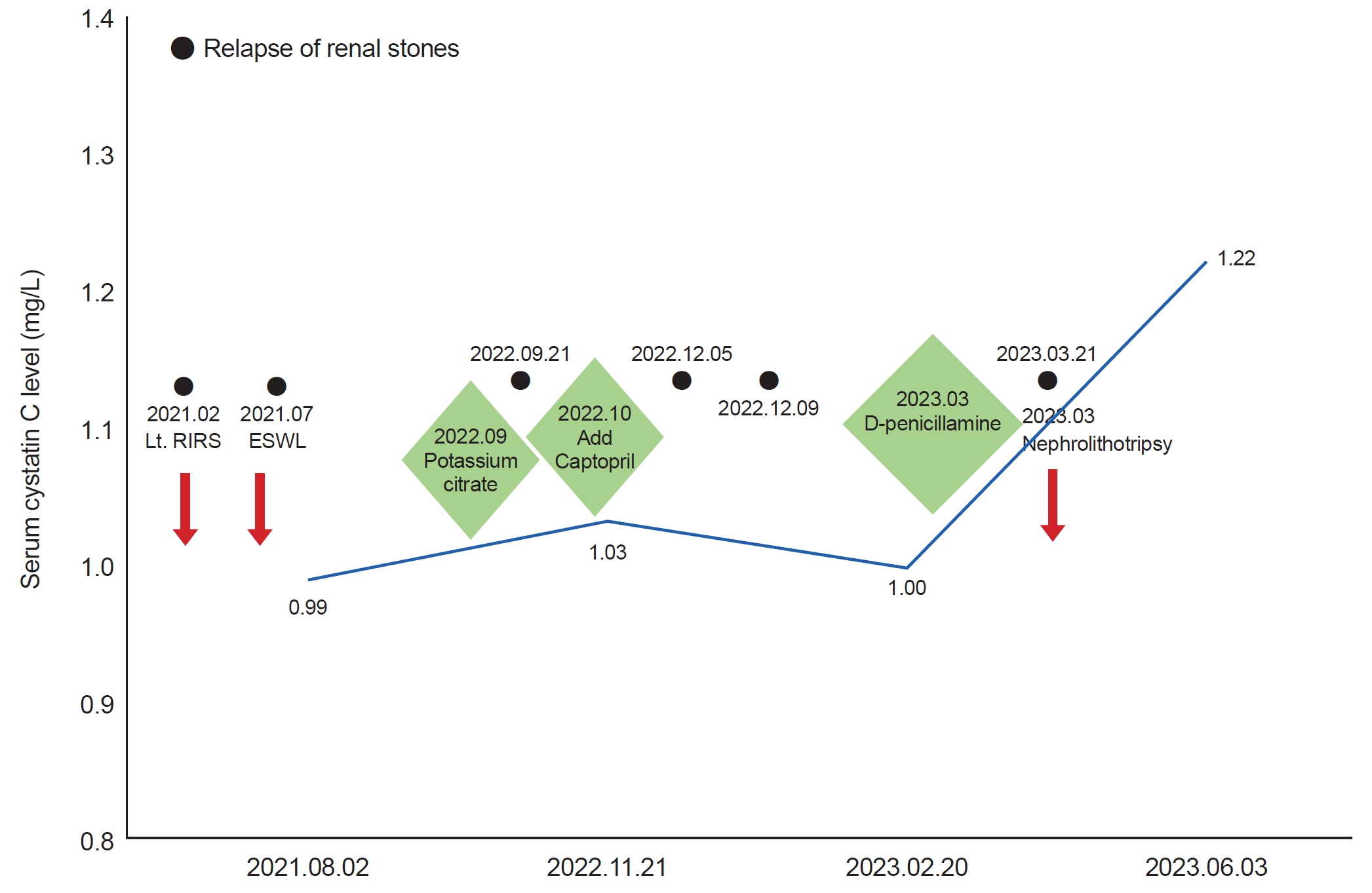Child Kidney Dis.
2023 Dec;27(2):127-132. 10.3339/ckd.23.014.
A case of cystinuria with a heterozygous SLC3A1 mutation presenting with recurrent multiple renal stones in a 14-year-old boy
- Affiliations
-
- 1Department of Pediatrics, Korea University Ansan Hospital, Ansan, Republic of Korea
- KMID: 2549745
- DOI: http://doi.org/10.3339/ckd.23.014
Abstract
- Cystinuria, a genetically inherited disorder, is a rare cause of kidney stones. It is characterized by impaired transport of cystine and amino acids in the proximal renal tubule and the small intestine. Most patients develop cystine stones throughout their lifetime. Recurrent renal stones need to be extracted by repeated urologic interventions. Treatment options of cystinuria for preventing stone recurrence are limited and poorly tolerated. In this study, we report a pediatric case of cystinuria with a heterozygous SLC3A1 mutation diagnosed by stone analysis, measurement of urine cystine excretion, and genetic analysis. There were recurrent renal stones despite repetitive shock wave lithotripsy and retrograde intrarenal surgery. However, the rate of stone formation seemed to be slower after D-penicillamine was added into adequate hydration and urinary alkalinization.
Keyword
Figure
Reference
-
References
1. Servais A, Thomas K, Dello Strologo L, Sayer JA, Bekri S, Bertholet-Thomas A, et al. Cystinuria: clinical practice recommendation. Kidney Int. 2021; 99:48–58.
Article2. Sahota A, Tischfield JA, Goldfarb DS, Ward MD, Hu L. Cystinuria: genetic aspects, mouse models, and a new approach to therapy. Urolithiasis. 2019; 47:57–66.
Article3. de Sanctis L, Bonetti G, Bruno M, De Luca F, Bisceglia L, Palacin M, et al. Cystinuria phenotyping by oral lysine and arginine loading. Clin Nephrol. 2001; 56:467–74.4. Knoll T, Zollner A, Wendt-Nordahl G, Michel MS, Alken P. Cystinuria in childhood and adolescence: recommendations for diagnosis, treatment, and follow-up. Pediatr Nephrol. 2005; 20:19–24.
Article5. Jung HD, Seo IY, Lee JY. Large database study of urinary stone composition in South Korea: Korean Society of Endourology and Robotics (KSER) research series. Investig Clin Urol. 2021; 62:462–9.
Article6. Markazi S, Kheirollahi M, Doosti A, Mohammadi M, Koulivand L. A novel mutation in SLC3A1 gene in patients with cystinuria. Iran J Kidney Dis. 2016; 10:44–7.7. Kim JH, Park E, Hyun HS, Lee BH, Kim GH, Lee JH, et al. Genotype and phenotype analysis in pediatric patients with cystinuria. J Korean Med Sci. 2017; 32:310–4.
Article8. Moussa M, Papatsoris AG, Abou Chakra M, Moussa Y. Update on cystine stones: current and future concepts in treatment. Intractable Rare Dis Res. 2020; 9:71–8.
Article9. Jung HD, Lee JY, Kang DH, Ko K, Koh DH, Kwon O, et al. Korean Society of Endourology and Robotics (KSER) recommendation on the diagnosis, treatment, and prevention of urolithiasis. Investig Clin Urol. 2023; 64:325–37.
Article10. Jeong JY, Oh KJ, Sohn JS, Jun DY, Shin JI, Lee KH, et al. Clinical course and mutational analysis of patients with cystine stone: a single-center experience. Biomedicines. 2023; 11:2747.
Article11. Tanzer F, Ozgur A, Bardakci F, Cankorkmaz L, Ayan S. Analysis of a 1-year-old cystinuric patient with recurrent renal stones. Int J Urol. 2006; 13:1347–9.
Article12. Tangnararatchakit K, Ariyaprakai W, Tapaneya-Olarn W, Shotelersuk V, Petchthong T. Cystinuria: cause of recurrent renal stones in a 4-year-old girl. J Med Assoc Thai. 2002; 85 Suppl 4:S1281–6.13. Halperin EC, Thier SO, Rosenberg LE. The use of D-penicillamine in cystinuria: efficacy and untoward reactions. Yale J Biol Med. 1981; 54:439–46.14. Kowalczyk NS, Zisman AL. Cystinuria: review of a life-long and frustrating disease. Yale J Biol Med. 2021; 94:681–6.15. Prot-Bertoye C, Lebbah S, Daudon M, Tostivint I, Bataille P, Bridoux F, et al. CKD and its risk factors among patients with cystinuria. Clin J Am Soc Nephrol. 2015; 10:842–51.
Article
- Full Text Links
- Actions
-
Cited
- CITED
-
- Close
- Share
- Similar articles
-
- A Case of Cystinuria with Multiple Renal Stones in an 8-month-old Girl
- Non-Type I Cystinuria Associated with Mental retardation and Ataxia in a Korean Boy with a New Missence Mutation(G173R) in the SLC7A9 Gene
- Genotype and Phenotype Analysis in Pediatric Patients with Cystinuria
- Prenatal Detection of Fetal Cystinuria by Fetal Hyperechoic Colon in Ultrasonogra phy: A Case Report
- Cystinuria 3 Cases




